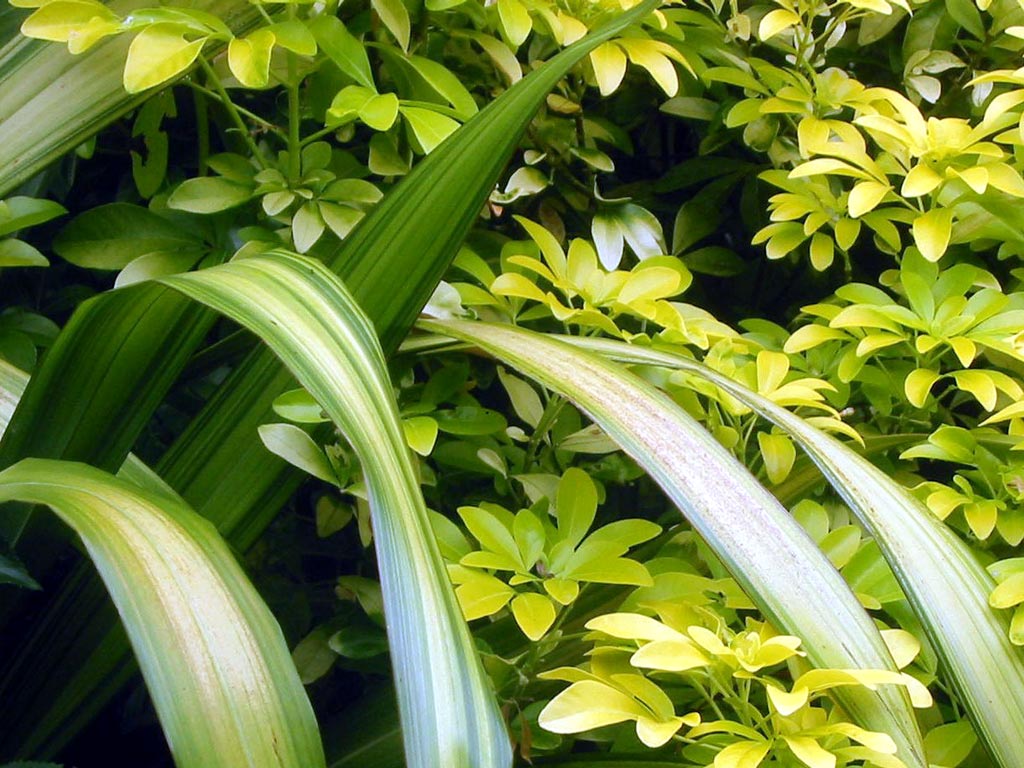Homeowners planning decorative gardens usually think of designs planned around flowers. While flower gardens are lovely, today’s gardeners are increasingly drawn to designs that focus on foliage as the main element. While flowers bloom and fade as the season progresses, foliage offers vibrant color and texture throughout the growing season.

Plan a Foliage Garden
The term “foliage” refers to the leaves on individual plants and groupings of plants. A nearly endless variety of plants are available in an array of vibrant leaf colors. A wide variety of plant shapes, sizes and textures allow gardeners to create stunning looks to suit any location. When planning a foliage garden, take time to consider the characteristics and needs of each plant.
Foliage Plant Colors
Foliage plants are available in colors ranging from creamy white to deep purples and burgundies. Some leaves are blue or nearly black, while others are various shades of gold, green or yellow. Leaves may be a single color, or variegated with stripes or spots. Some of these colorful plants produce flowers. Removing these blooms helps keep the plant lush and full.
Choosing Plants for Color
When choosing foliage for color, do a little research. Sunlight and temperature can affect leaf color. Some plants need full sun and will lose color in the shade. Others require full shade for full color. Some plants show color only in the fall, while others are colorful throughout spring and summer. When selecting plants, consider both the desired appearance and the environment in which the plant will grow.
Choosing Plant Textures
When it comes to texture, most people think of the tactile nature of leaves. Leaves may be smooth, furry, or spiny. While tactile characteristics are a consideration, visual texture is the most important element of garden design. For example, a gardener may choose the narrow, upright leaves of ornamental grass to create a fountain-like accent. Other plants create mounding or carpeting effects. Fine, medium and coarse textures affect the look of the garden in different ways.
Fine Textures
Plants with fine textures tend to make gardens appear larger while adding a graceful, delicate look. These plants have small leaves or blossoms and bring a light, airy feel to the garden. A classic example of a fine-leafed plant is the maidenhair fern with its graceful fronds. Trees and shrubs, such as the Japanese maple and dwarf yew, may also bring fine textures to the garden.
Medium Textures
Medium textures provide the foundation of the garden, creating a background against which other textures stand out. These plants have medium-sized leaves with simple shapes and smooth edges. Medium textures act as a unifying element that connects coarse and fine textures, and can also add a playful or sensual quality to the garden. Scented geraniums provide a splash of color and release an aroma when brushed. Lamb’s ear provides an enticing, furry texture.
Coarse Textures
Coarse textures create a bold impact in the garden. Plants with coarse textures have large leaves or blossoms and tend to make gardens feel smaller. Used as accents, these plants attract the eye and create interesting focal points. The variegated yucca, with its thick, sword-shaped leaves, creates a dramatic vertical accent. A large group of low-growing ice plant adds a lush, bluish-green contrast.
This year, consider devoting a <b>small garden</b> bed to foliage plants for a look that adds new dimension to the landscape.
Harrison writes for www.bonsaitreegardener.net about bonsai trees, tools and bonsai tree care. Recently he published a post about bonsai starter trees and a post on bonsai pots.




























.jpg)













































